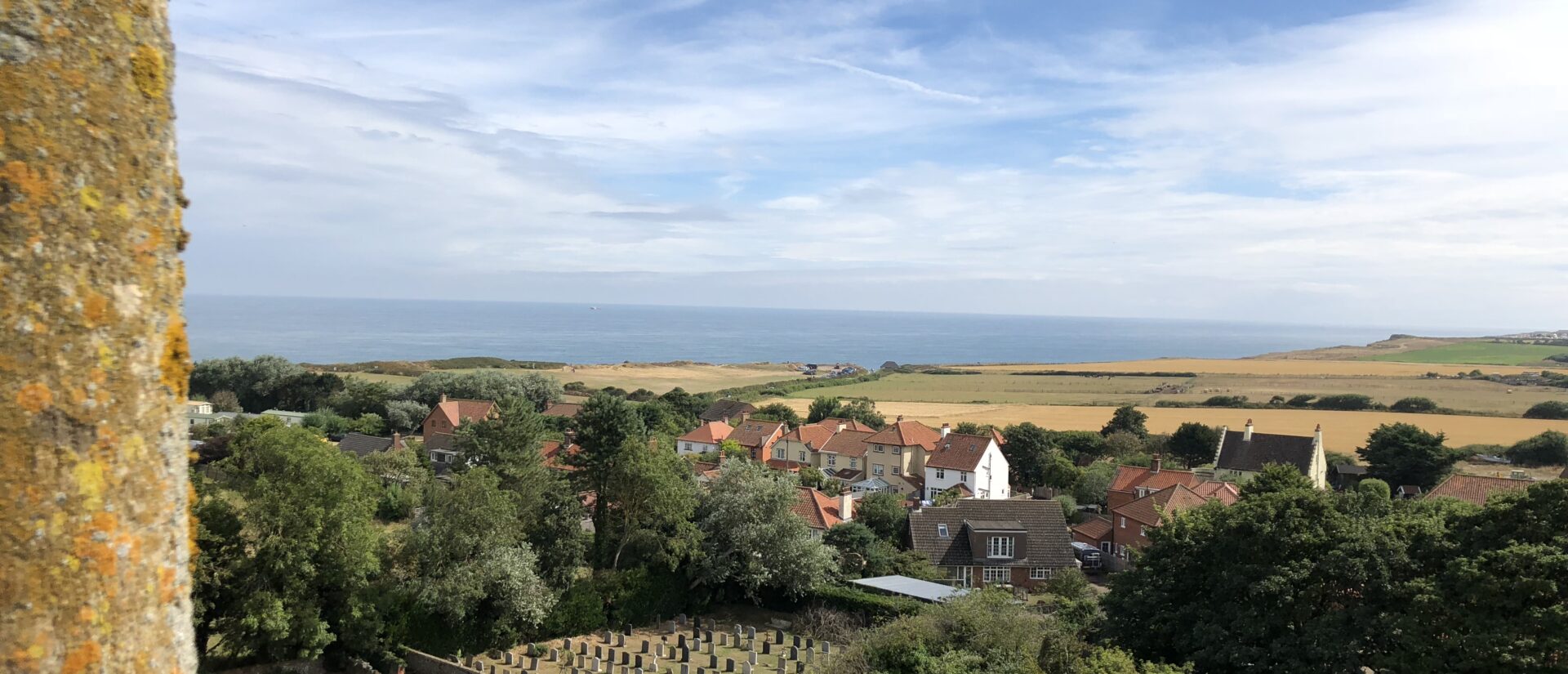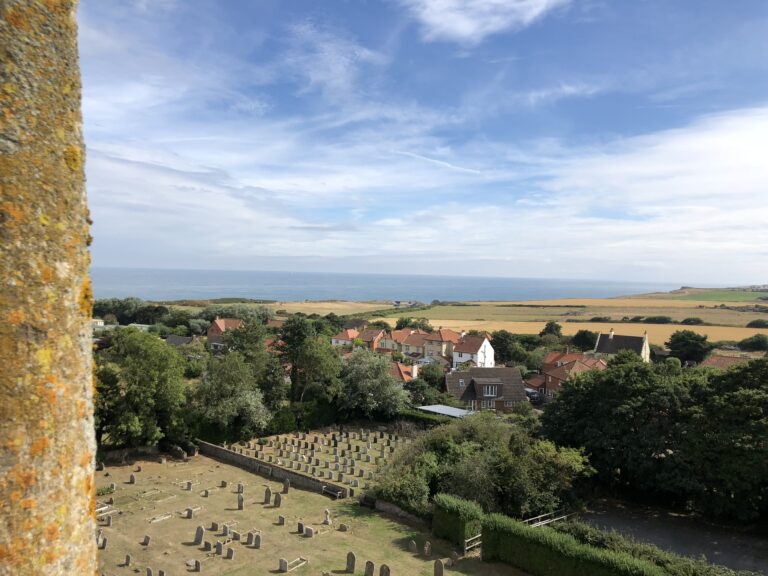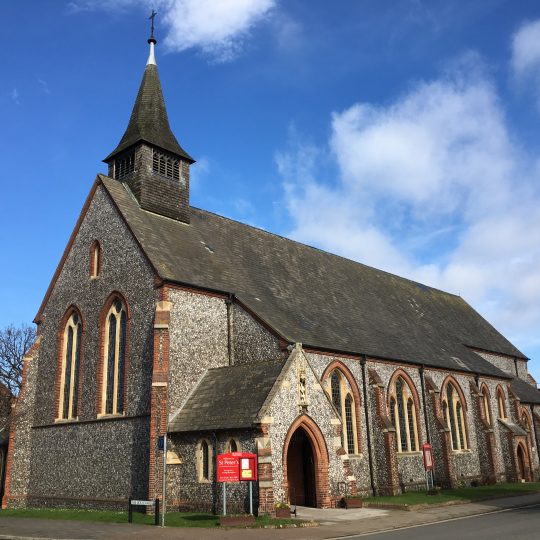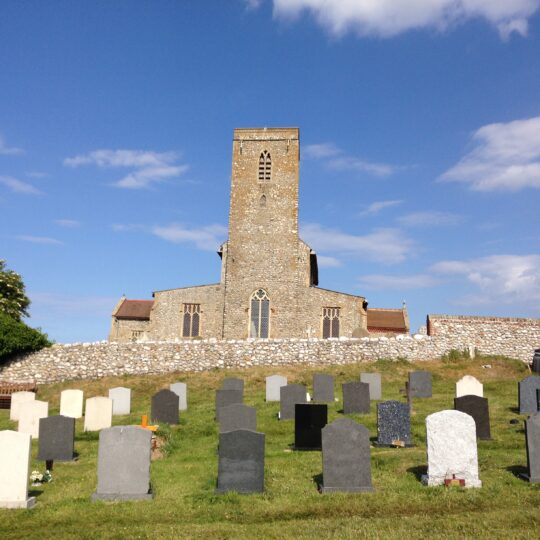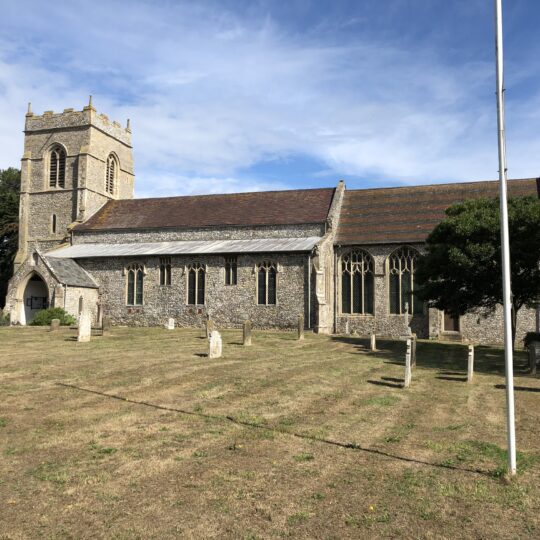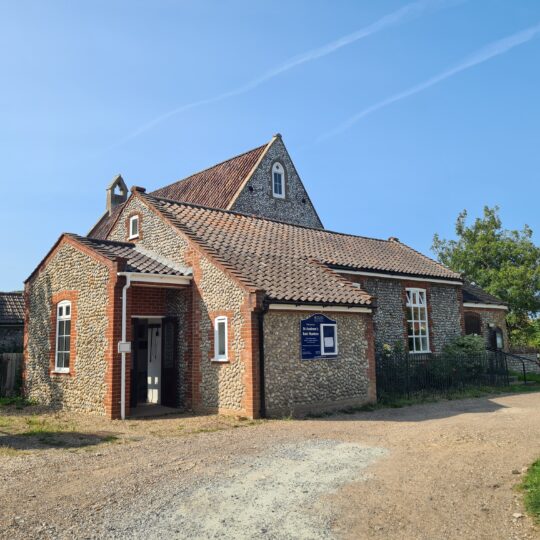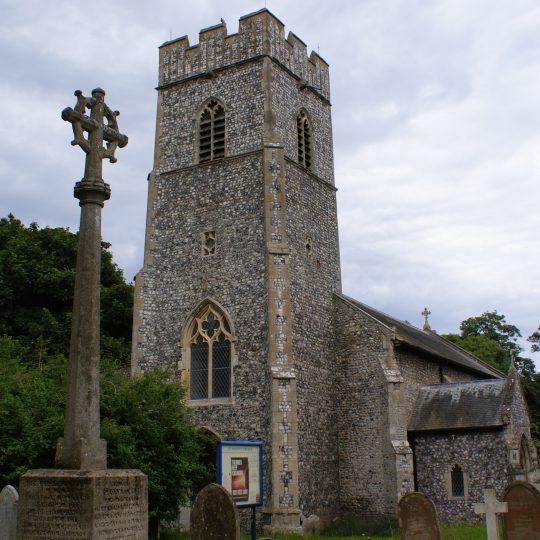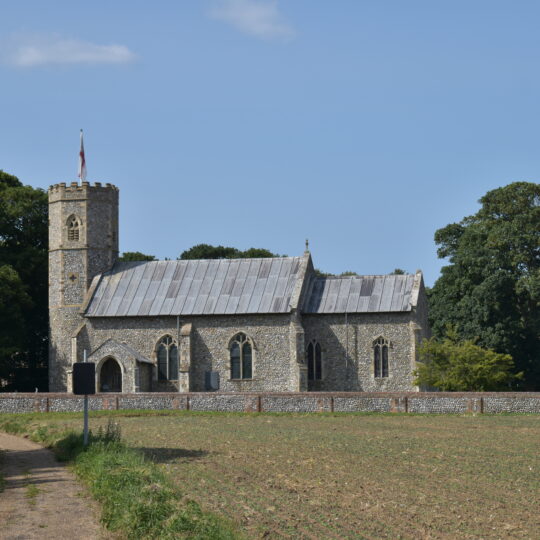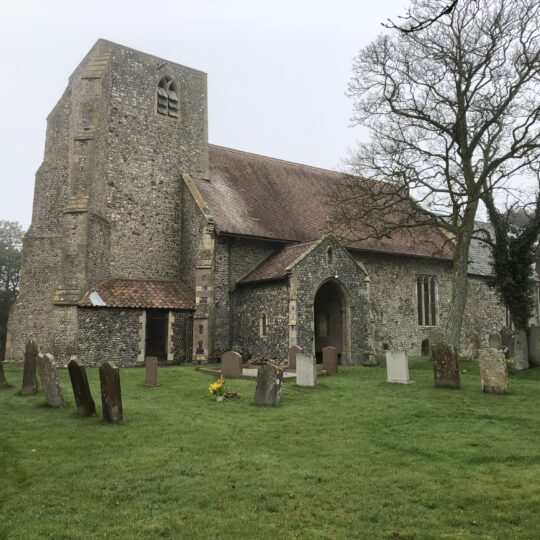From Brokenness to New Life: Sheringham to Trimingham Trail
Inspired by this church and by the wonderful walks, scenery and fresh air of North Norfolk, fostering the wellbeing enjoyed by our visitors, this walk has been prepared so that everyone is able to derive the spiritual benefit of this journey.
The walk is around ten miles and may be taken slowly in stages, or at a faster pace from start to finish in one day. It is possible on foot, or using the Coasthopper bus to each of the villages and towns on the route, or by car to all expect for Trimingham which has no car park, and so the last section will need to be taken on foot or by bus. The route meanders in and out of the Norfolk Coast Path/ King Charles III Coast Path and other existing routes which are accessible online. Given the rate of coastal erosion there will inevitably be revisions over time.
It is important to wear stout footwear and to be aware of uneven ground, mud, traffic on roads with no pavements, railway crossings, sand and shingle, and clifftop paths where there are no barriers as we take this pilgrimage, to keep ourselves and any companions, whether human or canine, safe from harm.
Our pilgrimage trail begins in the church of St Peter in Sheringham. It is a bright, welcoming church: an inclusive church of today.
St. Peter’s Church in Sheringham was built as the daughter church of All Saints, Upper Sheringham, in 1897 and it wasn’t until 1953 that it became the parish church of Sheringham. In 1910, the choir and clergy vestries on the north side were built. In 1928 the reredos (the decorated wooden screen behind the altar) was added. In 1930 the north and south sides of the chancel were paneled in oak. In 1931-2 the low screens at the top of the chancel steps were added. In 1933 the Chapel of the Holy Spirit was dedicated. The overall impression on entering St. Peter’s is one of enormous spaciousness and light. with the wide nave extending into the side aisles. It has never had pews. The interior is bold in design, an impression generated by the ridge of the roof, which is carried in one continual line throughout from east to west. The roof of the chancel is the same height as that of the nave. The chancel and porches have splendid mosaic floors. Above the altar the story of the Ascension is depicted in stained glass, whilst in the Chapel of the Holy Spirit the windows show the Transfiguration, the Baptism of Christ and the Garden of Gethsemane. Along the south aisle are the windows depicting St. Peter, St. George, St. Andrew, St. David and St. Patrick, together with a very fine carving of St. Peter. On the north side are windows bearing the shields of the four Evangelists. At the west end, stained glass windows show symbols of Baptism, Communion, Confirmation and Marriage.
We may notice how connected the church is to the town, the land, the sea and the world in the bespoke altar cloth and the prayer stations; be inspired by the stories depicted in the stained glass windows and find connections with our lives today in all that is on offer here.
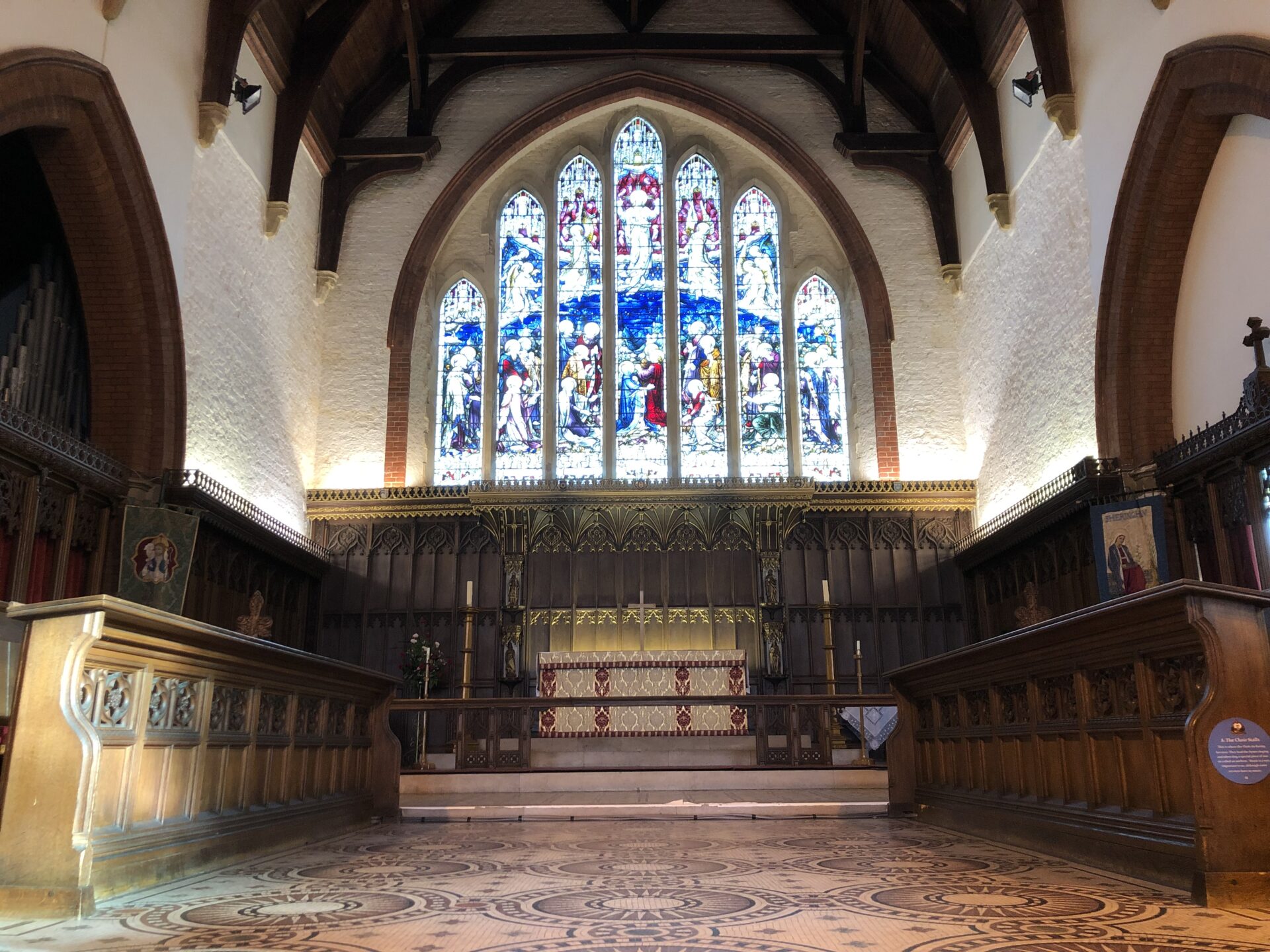
As we set off, we leave the church of St Peter and turn left into Church Street, pass the town clock, continue along the High Street and turn right into Wyndham Street, which runs into Beeston Road. We keep walking until we reach Priory Road on the left. Immediately on the right hand side in Priory Road there is a footpath which runs alongside a beck. We walk alongside the beck until we reach Curtis Lane and turn right to walk along the road, under the bridge and immediately left to continue alongside the beck. We carry straight on when the path makes way for the road and continue ahead until we can go no further. There we turn right along the track, to find Beeston Regis Priory ruins on our left.
We may notice on the way:
A blue plaque marking the place of a medieval chapel here;
Another plaque where the first bomb of WWI was dropped;
The flowers in season;
The sound of the rippling beck.
This was a medieval monastery church with ponds. We could spend time here to reflect upon any area of our lives where there is brokenness. We may notice how plants grow on the walls of the ruins, how the skies and trees are framed by the gaps in the ruins, and how beautiful the ruins are despite their brokenness.
We retrace our steps from the Priory ruins and turn right into Church Lane, a cul-de-sac leading to a footpath which runs alongside the railway line. We continue along this path passing the allotments until we reach a gate on the left hand side which crosses the line. We take great care to cross safely, then we turn immediately right to continue alongside the railway line until we reach the church of All Saints in Beeston Regis.
We may notice on the way:
That the path is so narrow for a while that we need to walk singly until it opens out and we can walk side by side with others again;
The crops in season as we pass by the allotments;
The sound of the rippling water of the brook which passes under our path as we come to the field and catch sight of the church.
All Saints’ Church in Beeston Regis is a gem on the North Norfolk coast, positioned on high ground. The church is a local landmark as it stands in comparative isolation near the cliff tops. The late 11th century/early 12th century square tower is unusual for the time when most Norfolk churches were built with round towers. The church is worth visiting simply for its fine 15th century rood screen featuring the twelve apostles. Though much restored it originates from the 15th century, having been completed in around 1480, and the painted panels date from that period. Like many screens this one suffered from neglect and possibly also deliberate damage in the Reformation, the Puritan era and the anti Gothic art movement in the 18th century. The high altar in the chancel dates from 1946. It is of carved oak and was given in memory of Flying Officer Richard Wyndham Ketton Cremer. He was brother of the owner of Felbrigg Hall but more importantly he was the owner of Beeston Hall. It was Richard’s death on active service in Crete in 1941 that resulted in Beeston Hall being used as a school which eventually bought the Hall when opportunity arose. The pews in the centre of the nave are Victorian but those in the aisles contain remains of older pews, possibly 15th century, including the carved pew ends, known as poppyheads, thought to be derived from the French word “poupee” – puppet or figurehead. There are carved animals on the arms of the old Clerk’s chair. The chancel rails date from the 17th century.
We may notice the window of the crucifixion, where Jesus blesses the continuing relationship of his mother Mary with John his closest friend at the time when he has to leave them to live without him; and wonder whether God
was suffering alongside us in the painful times, while celebrating with us in the good times. We may find the carved words ‘Watch and Pray’ and spend time in silence, simply listening to whatever is being revealed to us; notice both the window and the statue of St Francis who was able to come close to God through every living creature and the beauty of nature, and wonder whether we are able to do so too. Many visitors remark on the peaceful atmosphere of this church, reflecting more than 900 years of worship and devotion.
All Saints, Beeston Regis
On leaving the church we return to the path, continuing alongside the railway line until we reach West Runton. We take great care as we cross the road to walk along the pavement until we reach Holy Trinity church on our left, where we need to cross once again.
We may notice on the way:
A rosemary bush growing against the wall as we leave, and another as we arrive;
The variety of wild plants along the sides of the path, many of which are herbs which were introduced long ago for their healing properties;
Graffiti which confronts us on the walls alongside the line;
Delightful cultivated flowers in the gardens we pass.
Holy Trinity, West Runton sits on a rise above the coast road and is a typical long flint and stone building of the 12th century. The attractive Victorian lychgate has been moved back from the busy main road and has the carved inscription ‘O enter into His gates with thanksgiving and into His courts with praise ….. be thankful unto Him’. The interior, which was extensively restored in 1854 and 1886, is wide and light with a mixture of old and new pamment flooring in terracotta and ochre. The restorations replaced most of the window traceries and the roofs. In the choir, some old poppyhead carvings have been grafted onto the Victorian pews of 1886. Though rather battered, one can make out a medieval lady, a merchant, various seedheads, and a monstrous face with its tongue out. There are fragments of medieval glass in the south choir tracery. The five-light east window was designed by Edward Frampton, and was inserted in 1896. His also are the south chancel windows of St. George and St. Cecilia, after 1896, and the south aisle window of the Resurrection. Some Art & Crafts influence is seen in his window at the east end of the south aisle, dating from 1911, where St. Francis preaches to the birds.
We could spend time in the church beginning to think about all aspects of our lives in the present day. We may find the carved words ‘Watch and Pray’ and spend time in silence, simply listening to whatever is being revealed to us; notice both the window and the statue of St Francis who was able to come close to God through every living creature and the beauty of nature, and wonder whether we are able to do so too.
Holy Trinity, West Runton
On leaving the church we turn left to walk along the narrow pavement to the Village Inn, and then turn left into Water Lane. The pavement peters out as the road bends to the right, and we walk along the road until we see a direction sign for the Coast Path on our right where there is a large elephant.
There are public conveniences and a café nearby if we require them before we continue on our way. We take the coast path and follow it until we go through a camp site and reach the road at East Runton, where we turn left and walk along the pavement. We cross the road, pass a former Methodist Church, and take the right turn where there is a short stretch of pavement on the far side before we need to cross the road to take a track through the common, walking toward a viaduct. The Church of St Andrew is situated to our right before we reach the viaduct.
St Andrew’s Church in East Runton was originally a school. East Runton School belonged to the Buxton family and services were taken there from at least the 1890s by the rector of Beeston until 1918 when other premises had to be used. The school buildings were eventually sold to the PCC in 1959. The main part of the school was sold in 1977 for conversion to housing, leaving the current church building with the PCC. A large wooden cross to hang over the altar and a white Laudian altar cloth were gifted by a member of the congregation. Blue chairs were purchased from the parish church at Bournemouth, and the pews were sold for £30 each. A chest for storing vestments was gifted. It was time to turn the interior around, and on Advent Sunday the first Holy Communion at the north end was celebrated. The church at present consists of a single room, an extension to the east constructed of random ball flints with red bricks around the corners, windows and doors and an extension to the south comprising an entrance lobby and lavatory. There is a stone in the north gable end of the original building containing the date 1852.
St Andrew’s, East Runton
We leave the church and cross the road, to walk along Mill Lane. This runs into a track which leads us to Cromer. We do not take any turns to the right, and continue to bear left when reaching a bollard with a path ahead. The path comes out onto Howard’s Hill. We can see the church ahead of us, which dominates the town, but we cross the road and walk along Shipden Avenue to the main road, crossing it and the field to pick up the coast path and walk toward the town. We enjoy the walkway with views of the sea and pier before we bear right with the road, pass the garage, turn left into Church Street and make our way to the Church of St Peter and St Paul.
We may notice on the way:
The birdsong;
The old mill which is now a residence, perhaps giving us to reflect upon the stories of those people past and present who have been involved with the building in its lifetime, within a part of theirs;
How the road peters out into a single track path with sandy soil while the cultivated plants we pass make way for wild herbs and grasses;
The glimpses of the sea until we reach it and enjoy the sight and sound, noticing how it is constantly changing.
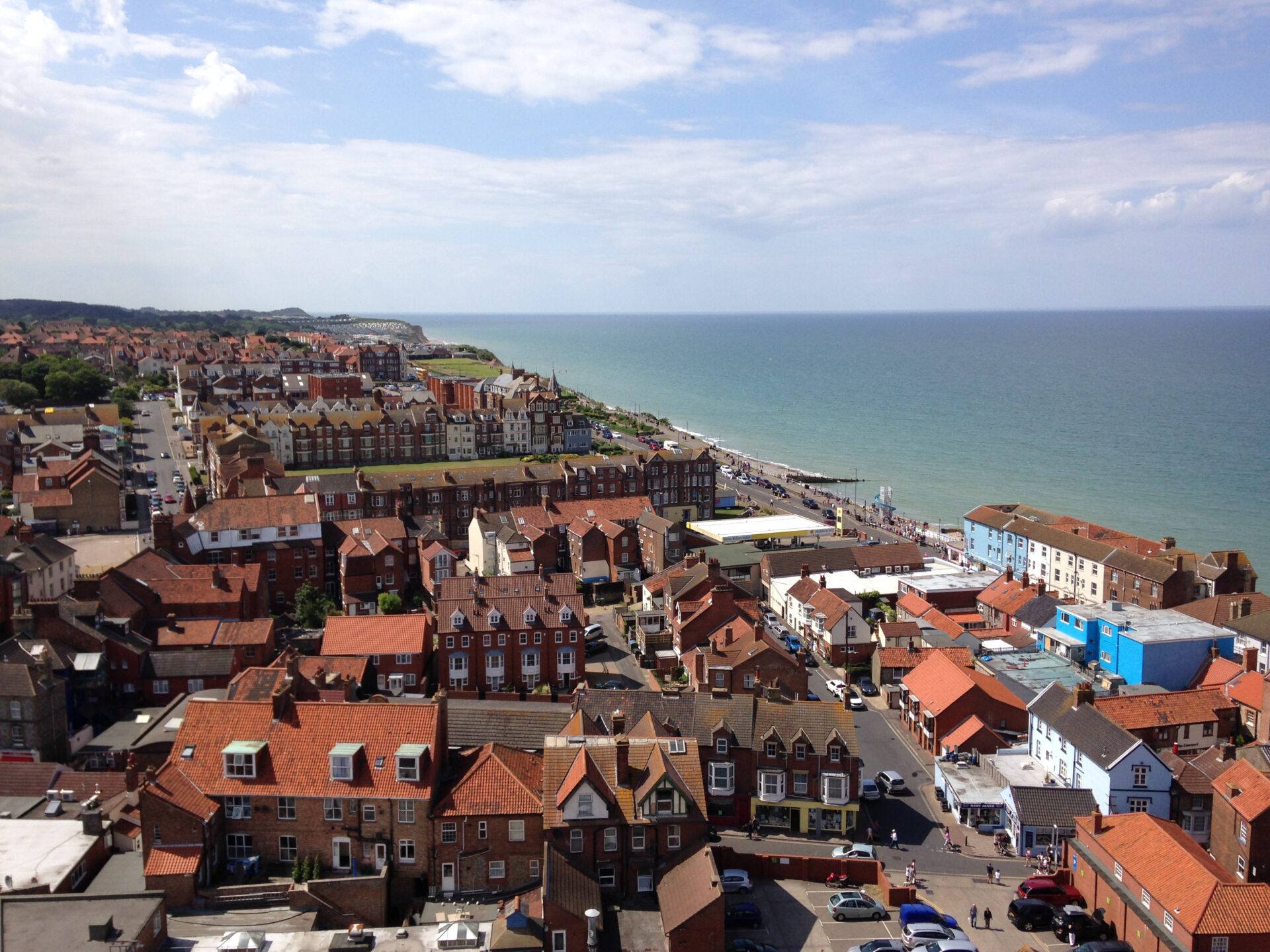 View from the tower of
St Peter and St Paul’s, Cromer
View from the tower of
St Peter and St Paul’s, Cromer
St Peter and St Paul, Cromer is a vast church at the heart of this seaside town. At 160ft, its tower is the tallest in Norfolk and walking the narrow streets you constantly glimpse it between the houses and over the rooftops. Before the installation of a lighthouse on the cliff at Foulness in 1669, a light was shone from the top of the church tower to act as a guide to shipping, according to Trinity House. Memorials in modern glass to Cromer’s seafarers can be found inside the church. Among them is Henry Blogg, the most decorated lifeboatman in RNLI history, who served for 53 years and saved 873 lives with the help of his brave crews before retiring in 1947. His many awards included the George Cross in 1941. The church was heavily restored in the 19th century after falling into disrepair. The restoration work included the installation of an impressive hammerbeam roof with carved angels. A side chapel provides a quiet space for private prayer; the east window in this chapel is by Sir Edward Burne-Jones.
The church is a magnet for people: whether locals sheltering from the rain, holidaymakers from home or abroad, children of all ages learning more, bird watchers hoping to see peregrine chicks, or visitors looking for a chat or to simply sit, this is a vibrant lively place. We may look for the wonderful window of the Ascension, which can cast a rainbow into the church when the sun shines through it, and reflect upon how much light we receive in our lives from those who are willing to be with us, to give us their time and attention.
St Peter and St Paul’s, Cromer
Upon leaving the church we turn right and head for the sea, checking to ensure that we avoid high tides in terms of both time and sea height. If we need to spend some time here waiting for the tide, there are shops and cafés in Cromer, and public conveniences in the main car parks. Passing the pier, we continue along the promenade and beach until we reach Overstrand. The beach consists of sand and shingle, with the sand providing easier walking once the tide has ebbed away, while it is necessary to walk on the shingle at times.
As we walk along the beach and hear the constant sound of the waves we may notice on the way:
How the water has made patterns and rivulets in the sand, and made smooth some of the pebbles – are we being sculpted too, by life?
Footprints made by others in the sand, knowing that we are not alone;
No footprints in the sand at times, with nobody else around;
The difference between walking on wet sand and doing so on shingle, which may remind us that some parts of our lives have been easier than others, while perhaps we have become stronger through rough terrain;
That the vibrant life represented by the pier in Cromer becomes more and more distant as we make our way to this last stretch of our pilgrimage;
Barriers on the beach which we must navigate around, and steps which we must climb along the way, culminating in a steep ramp as we ascend to Overstrand.
On reaching Overstrand promenade we continue past the first very steep path leading to the village, as there is another a little further on. When we reach the top we can see The Pleasaunce and the car park and public conveniences straight ahead, with the Clifftop Café across the road. As there are no facilities in Trimingham, we need to be prepared before we undertake the last stage of our pilgrimage. We cross to the café and walk along Cliff Road to the end, where we turn left, pass the Sea Marge hotel and follow the road around to the right, Carr Lane. When we reach the end we turn left and walk alongside the main road toward Sidestrand until we reach Tower Lane on our left. This will take us all the way to Trimingham along the coast path. If we want to take a detour to the church of St Martin in Overstrand, we need to turn right at the main road and continue to the church, then retrace our steps to walk toward Sidestrand until we reach Tower Lane on our left.
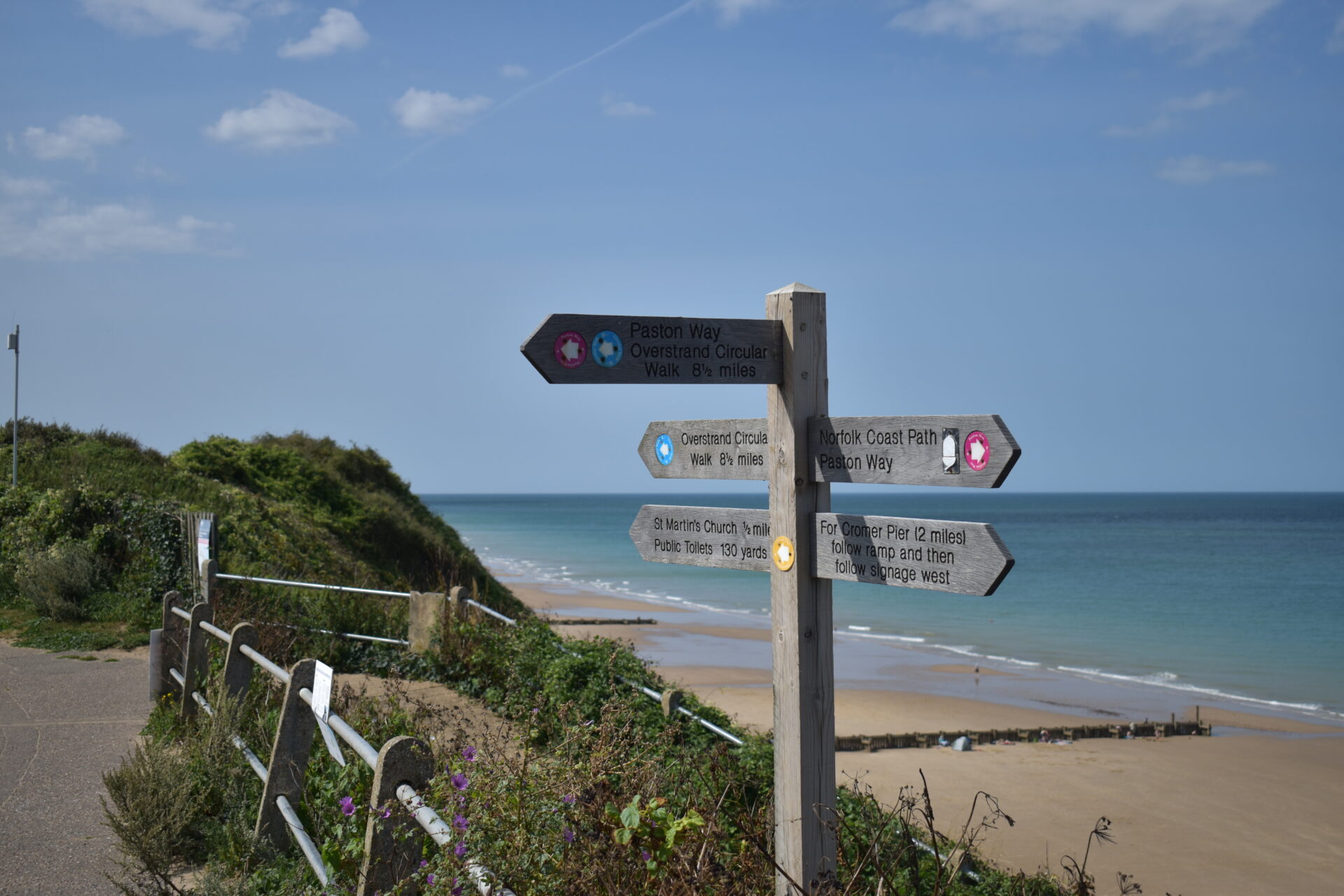
St Martin’s Church in Overstrand was in a ruinous state by the 19th century and another church was built next door in 1859 (Christ Church). St Martin’s Church underwent an extensive rebuilding and restoration in 1911. The 15th century nave and tower have survived but there is a new chancel and north aisle. Notice the wafer oven in the base of the tower. The original north doorway leads from the nave through to the north aisle. There is a memorial commemorating Sir Thomas Fowell Buxton MP who helped to set up the British and Foreign Anti-Slavery Society in 1823 and led the abolition movement following the retirement of William Wilberforce. He was also the chairman of the Society for the Prevention of Cruelty to Animals which later received royal assent from Queen Victoria in 1840.
Pilgrims passed this way toward Trimingham in the 14th and 15th centuries. There are stoups for holy water and a bread oven in the walls of the church of St Martin, and niches which might have been stoups in the walls inside the
private house which is now called ‘Monk’s Barn’, that we can see on our left as we head toward Sidestrand. We are alongside those who came before us.
St Martin’s, Overstrand
As we reach the clifftop path we are once again given fabulous views of the sea and skies, which can be very uplifting to the spirit. We may recall the window of St Francis which we noticed in West Runton along the way, and the peace of the church in East Runton. There is a sidetrack to the right shortly after passing the school grounds, with a treeline to the right, which leads to the round-towered Church at Sidestrand if we would like to go there, to return the same way in order to pick up the coastal path again toward Trimingham.
We may reflect as we walk upon what has been of the greatest importance in our lives, and what has been distracting or sidetracking us. Is there anything we want to do or say as we return to the everyday? What do we want to focus on and find time for? How might we do so?
The Church of St Michael and All Angels in Sidestrand originally had a Saxon tower with an octagonal top added in the 15th century. One night in 1841 it collapsed in a storm and a lower tower was built. MPs Samuel Hoare and Sir Thomas Fowell Buxton started fundraising to move the church to a safer position inland to protect it from coastal erosion. Much of the original masonry was reused and the new church was consecrated in 1881. The tower was left on the cliff edge and fell into the sea in 1916. The church inspired the poem by Clement Scott who wrote many articles about this area and made it famous as ‘Poppyland’ in the 19th century: ‘On the grass of the cliff, at the edge of the steep, God planted a garden – a garden of sleep.’ The headstones from the old churchyard are arranged along the present road-side wall. Note on the north aisle the communal grave for bones exposed in the old churchyard when the cliff fell. Inside, above the south door is a hatchment for Lord Templewood (d. 1959) and his wife (who d. 1962). The font is a plain octagon of the 15th century. The font cover was given in memory of Richard Hood who died aged 12 in 1930 of meningitis. Behind it, fixed to the wall are two pre-14th century stone coffin covers, taken from the original site in the old churchyard. One was known locally as the Crusader’s Stone. The nave is oak-panelled with names of departed members of the congregation. The stone corbels at the base of the roof have been painted red and marked with a cross in honour of St Michael. The organ was obtained from a church in Norwich.
Coastal erosion constantly affects the path we are taking on our pilgrimage. This and the crops in the fields we are passing could remind us that nothing stays the same. Like the church, we sometimes need to move to another place for our own wellbeing.
St Michael’s, Sidestrand
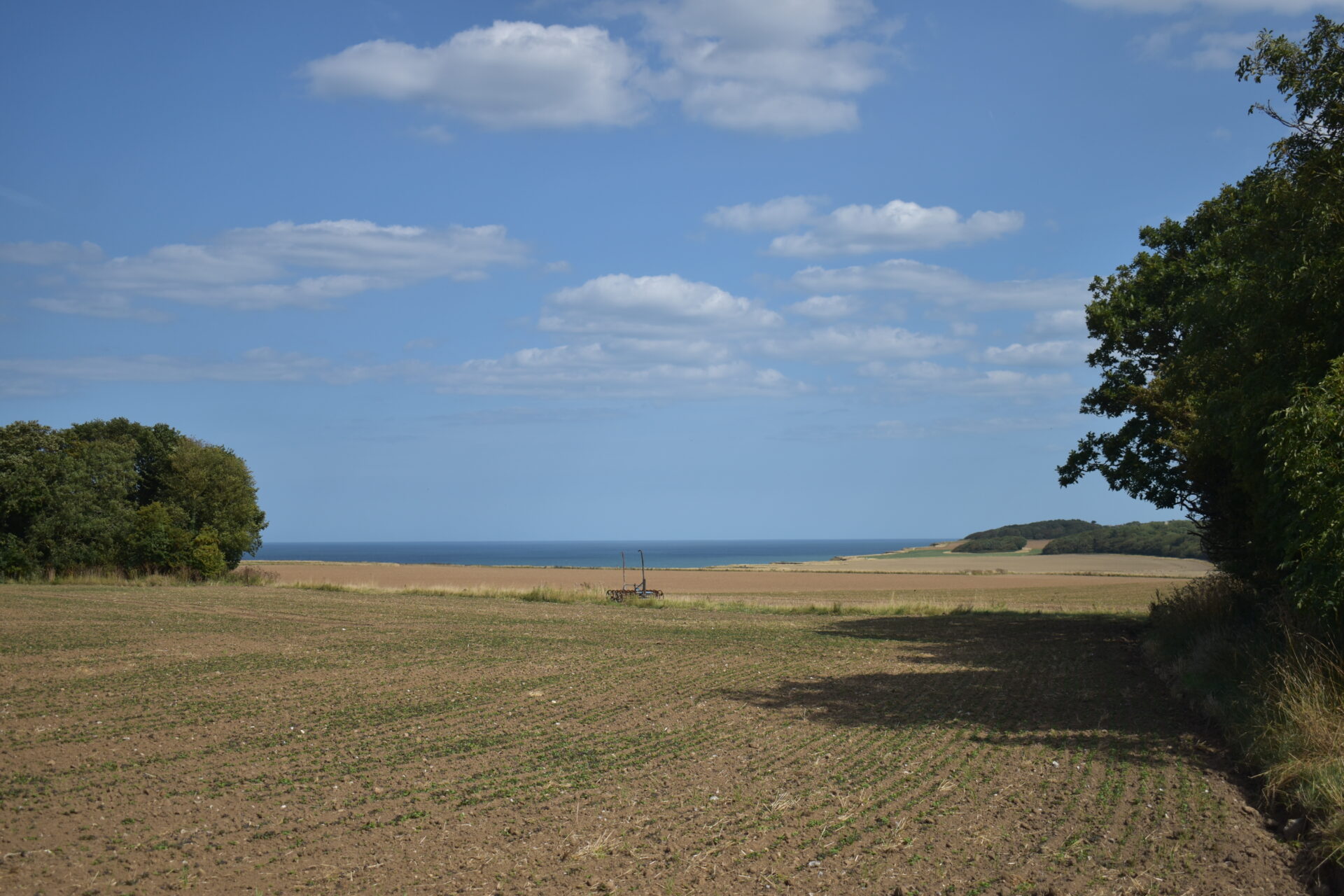
As we approach Trimingham the path takes us through two small copses and we could be tempted to go off track, but the coast path takes us directly to Loop Road which is opposite the church, and we can see it to our right.
When we have reached our destination we may find something among the many wonders in this church which speaks to us in new ways, giving us something to take away: whether its history as a pilgrim destination, the story of John the Baptist or any one of the saints portrayed by the rood screen, the fantastic carvings, a window, the building, the inspirational poem, or the boat.
Trimingham Church has a very unusual dedication. A local will noted that the head of St John the Baptist was kept here. More likely, this was an alabaster representation of the head. The ‘History, Gazetteer and Directory of Norfolk’ explains that pilgrims ‘came to see the head of St John the Baptist which the wily priests pretended they had got.’ There are only two other churches in England which share this dedication. The church is largely Perpendicular with an earlier tower. The nave was entirely rebuilt in 1854. Eight saints look out from the 16th Century rood screen, namely: Edmund, Clare, Clement, John the Baptist, Petronella, Cecilia, Barbara and another depiction of Edmund. There is a lovely pink stone double-headed piscina. Also worth observing are the distinctive carvings by the Revd Reginald Page who served as rector here in the early 20th century. His own memorial in the chancel looks, maybe unsurprisingly, like his work too.
St John the Baptist’s Head, Trimingham
Bus stops are nearby for return to Cromer on the Coasthopper, from which buses and trains are available to Sheringham and to Norwich.
